Abstract
The efficacies of daptomycin, teicoplanin, and vancomycin were compared in the therapy of experimental Staphylococcus aureus endocarditis. Rabbits infected with either of two methicillin-susceptible strains (SA-12871 or its moderately teicoplanin-resistant derivative SA-12873) or a methicillin-resistant S. aureus strain (MRSA-494) were treated with daptomycin, 8 mg/kg of body weight, every 8 h; teicoplanin, 12.5 mg/kg (low-dose teicoplanin [teicoplanin-LD], excluding MRSA-494) or 40 mg/kg (high-dose teicoplanin [teicoplanin-HD]) every 12 h; or vancomycin, 17.5 mg/kg every 6 h, for 4 days. Compared with no treatment daptomycin, teicoplamin-HD, and vancomycin significantly reduced bacterial counts of all test strains in vegetations and renal and splenic tissues (P less than 0.001). Teicoplanin-LD was equally effective against SA-12871 but failed against SA-12873, with three of six animals still being bacteremic at the end of therapy. For SA-12871, daptomycin was as effective as teicoplanin-HD and was superior to teicoplanin-LD and vancomycin (P = 0.02) in lowering vegetation bacterial counts. There were no differences between daptomycin, teicoplanin-HD, or vancomycin in the reduction of bacterial counts in tissues for any of the test strains. In rabbits infected with SA-12871, vegetations from 33% of teicoplanin-LD-treated, 6% of teicoplanin-HD-treated, and 13% of daptomycin-treated animals yielded organisms for which there were up to eightfold increases in the MICs. Resistance may have contributed to early death in one daptomycin-treated animal. No increases in the MICs for the test strain were detected in animals infected with SA-12873 or MRSA-494. We conclude that in this model and against these strains of S. aureus, daptomycin and teicoplanin-HD are as efficacious as vancomycin, but diminished susceptibility to both can develop during therapy.
Full text
PDF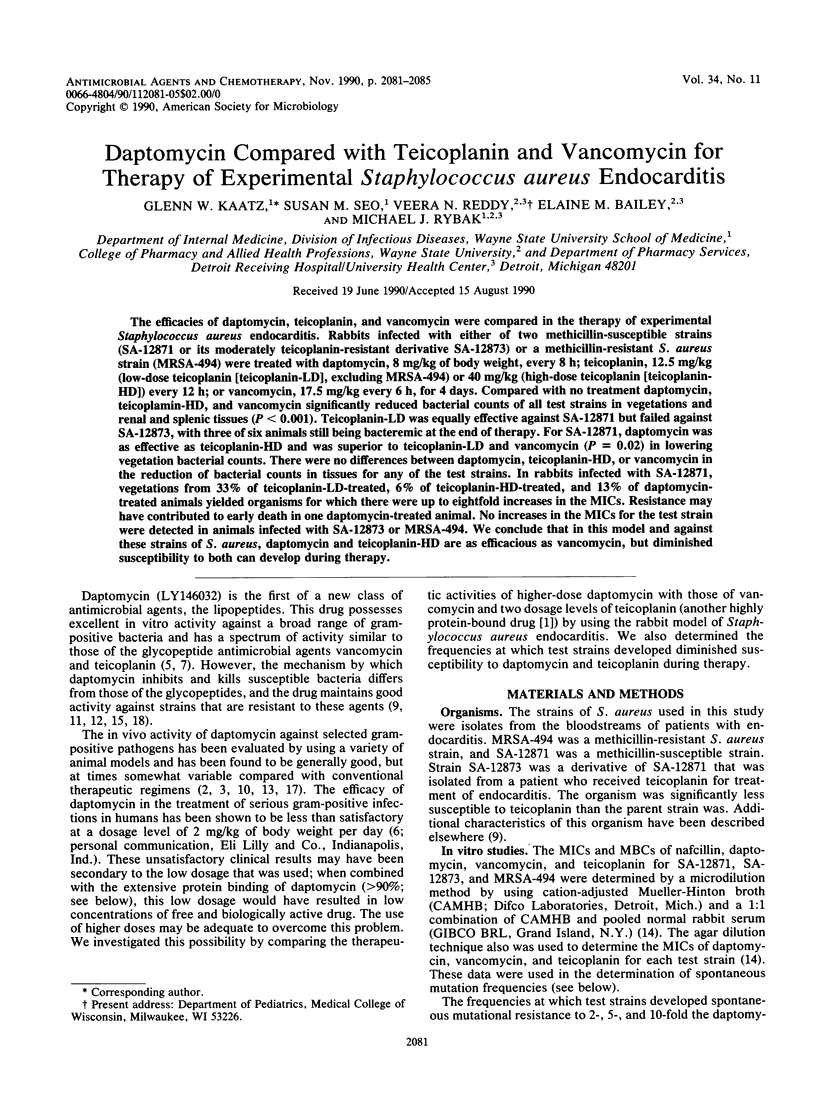
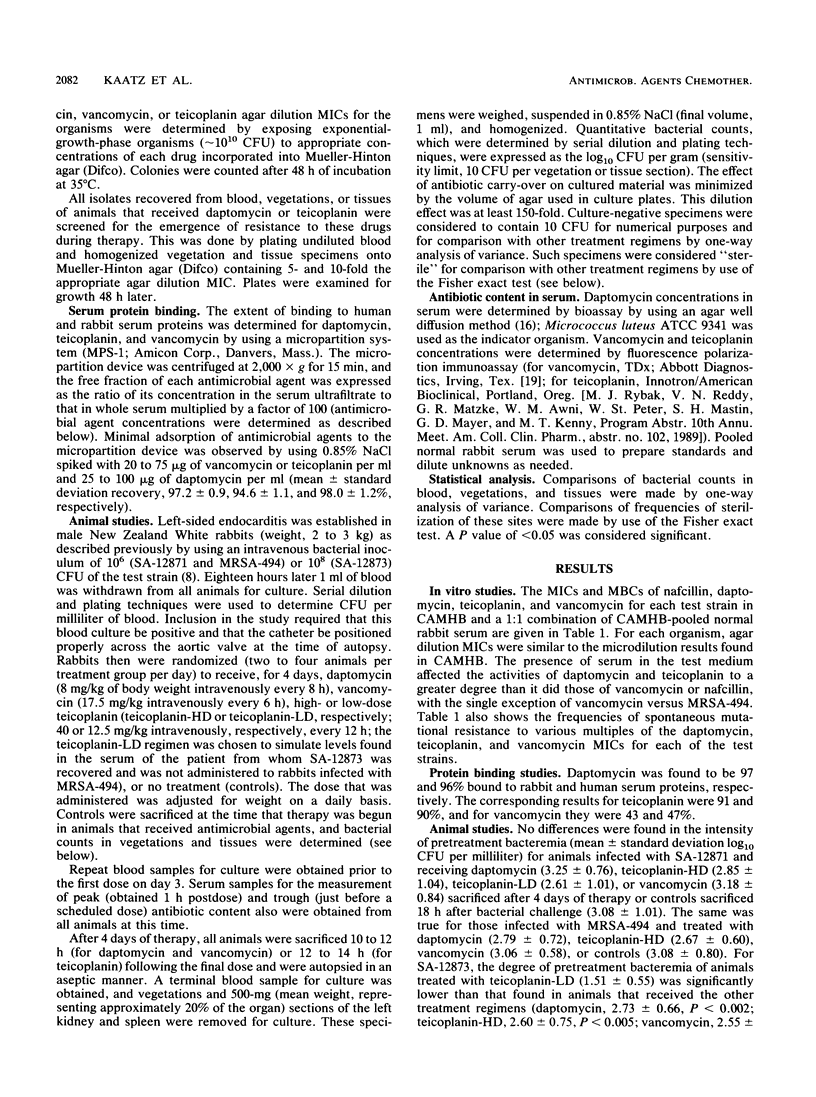
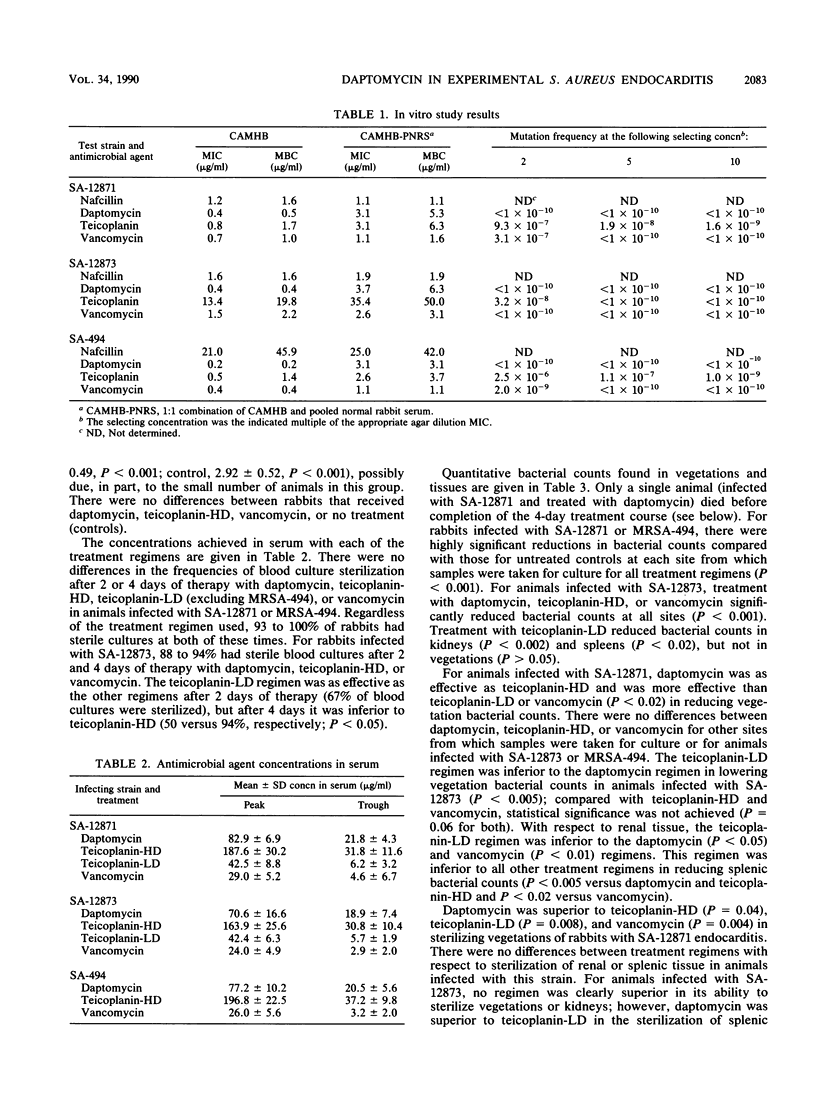
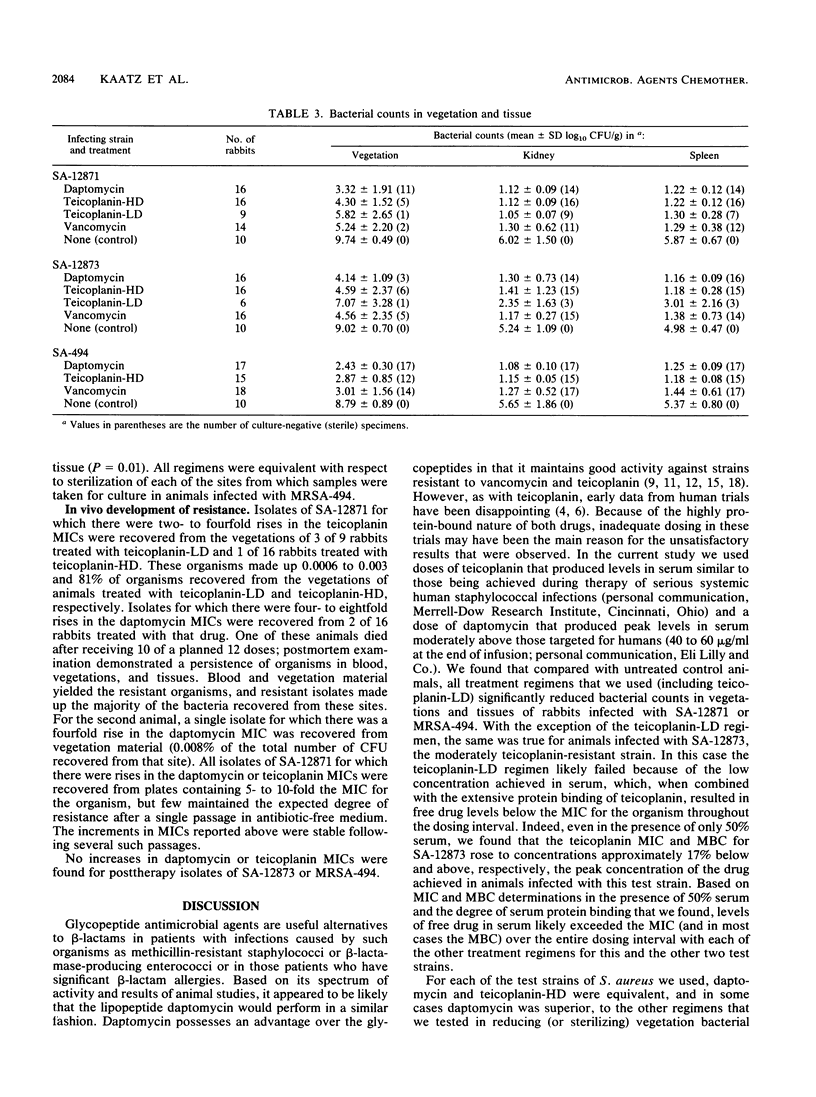
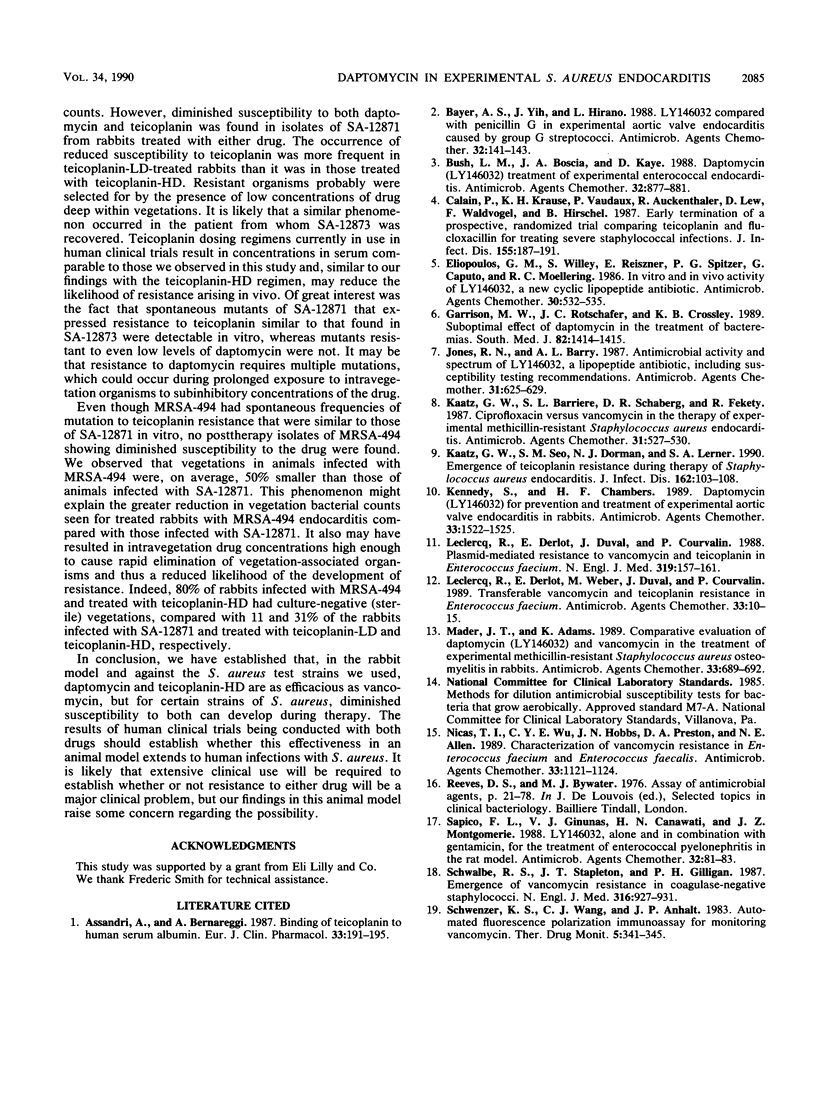
Selected References
These references are in PubMed. This may not be the complete list of references from this article.
- Assandri A., Bernareggi A. Binding of teicoplanin to human serum albumin. Eur J Clin Pharmacol. 1987;33(2):191–195. doi: 10.1007/BF00544566. [DOI] [PubMed] [Google Scholar]
- Bayer A. S., Yih J., Hirano L. LY146032 compared with penicillin G in experimental aortic valve endocarditis caused by group G streptococci. Antimicrob Agents Chemother. 1988 Jan;32(1):141–143. doi: 10.1128/aac.32.1.141. [DOI] [PMC free article] [PubMed] [Google Scholar]
- Bush L. M., Boscia J. A., Kaye D. Daptomycin (LY146032) treatment of experimental enterococcal endocarditis. Antimicrob Agents Chemother. 1988 Jun;32(6):877–881. doi: 10.1128/aac.32.6.877. [DOI] [PMC free article] [PubMed] [Google Scholar]
- Calain P., Krause K. H., Vaudaux P., Auckenthaler R., Lew D., Waldvogel F., Hirschel B. Early termination of a prospective, randomized trial comparing teicoplanin and flucloxacillin for treating severe staphylococcal infections. J Infect Dis. 1987 Feb;155(2):187–191. doi: 10.1093/infdis/155.2.187. [DOI] [PubMed] [Google Scholar]
- Eliopoulos G. M., Willey S., Reiszner E., Spitzer P. G., Caputo G., Moellering R. C., Jr In vitro and in vivo activity of LY 146032, a new cyclic lipopeptide antibiotic. Antimicrob Agents Chemother. 1986 Oct;30(4):532–535. doi: 10.1128/aac.30.4.532. [DOI] [PMC free article] [PubMed] [Google Scholar]
- Garrison M. W., Rotschafer J. C., Crossley K. B. Suboptimal effect of daptomycin in the treatment of bacteremias. South Med J. 1989 Nov;82(11):1414–1415. doi: 10.1097/00007611-198911000-00018. [DOI] [PubMed] [Google Scholar]
- Jones R. N., Barry A. L. Antimicrobial activity and spectrum of LY146032, a lipopeptide antibiotic, including susceptibility testing recommendations. Antimicrob Agents Chemother. 1987 Apr;31(4):625–629. doi: 10.1128/aac.31.4.625. [DOI] [PMC free article] [PubMed] [Google Scholar]
- Kaatz G. W., Barriere S. L., Schaberg D. R., Fekety R. Ciprofloxacin versus vancomycin in the therapy of experimental methicillin-resistant Staphylococcus aureus endocarditis. Antimicrob Agents Chemother. 1987 Apr;31(4):527–530. doi: 10.1128/aac.31.4.527. [DOI] [PMC free article] [PubMed] [Google Scholar]
- Kaatz G. W., Seo S. M., Dorman N. J., Lerner S. A. Emergence of teicoplanin resistance during therapy of Staphylococcus aureus endocarditis. J Infect Dis. 1990 Jul;162(1):103–108. doi: 10.1093/infdis/162.1.103. [DOI] [PubMed] [Google Scholar]
- Kennedy S., Chambers H. F. Daptomycin (LY146032) for prevention and treatment of experimental aortic valve endocarditis in rabbits. Antimicrob Agents Chemother. 1989 Sep;33(9):1522–1525. doi: 10.1128/aac.33.9.1522. [DOI] [PMC free article] [PubMed] [Google Scholar]
- Leclercq R., Derlot E., Duval J., Courvalin P. Plasmid-mediated resistance to vancomycin and teicoplanin in Enterococcus faecium. N Engl J Med. 1988 Jul 21;319(3):157–161. doi: 10.1056/NEJM198807213190307. [DOI] [PubMed] [Google Scholar]
- Leclercq R., Derlot E., Weber M., Duval J., Courvalin P. Transferable vancomycin and teicoplanin resistance in Enterococcus faecium. Antimicrob Agents Chemother. 1989 Jan;33(1):10–15. doi: 10.1128/aac.33.1.10. [DOI] [PMC free article] [PubMed] [Google Scholar]
- Mader J. T., Adams K. Comparative evaluation of daptomycin (LY146032) and vancomycin in the treatment of experimental methicillin-resistant Staphylococcus aureus osteomyelitis in rabbits. Antimicrob Agents Chemother. 1989 May;33(5):689–692. doi: 10.1128/aac.33.5.689. [DOI] [PMC free article] [PubMed] [Google Scholar]
- Nicas T. I., Wu C. Y., Hobbs J. N., Jr, Preston D. A., Allen N. E. Characterization of vancomycin resistance in Enterococcus faecium and Enterococcus faecalis. Antimicrob Agents Chemother. 1989 Jul;33(7):1121–1124. doi: 10.1128/aac.33.7.1121. [DOI] [PMC free article] [PubMed] [Google Scholar]
- Sapico F. L., Ginunas V. J., Canawati H. N., Montgomerie J. Z. LY146032, alone and in combination with gentamicin, for the treatment of enterococcal pyelonephritis in the rat model. Antimicrob Agents Chemother. 1988 Jan;32(1):81–83. doi: 10.1128/aac.32.1.81. [DOI] [PMC free article] [PubMed] [Google Scholar]
- Schwalbe R. S., Stapleton J. T., Gilligan P. H. Emergence of vancomycin resistance in coagulase-negative staphylococci. N Engl J Med. 1987 Apr 9;316(15):927–931. doi: 10.1056/NEJM198704093161507. [DOI] [PubMed] [Google Scholar]
- Schwenzer K. S., Wang C. H., Anhalt J. P. Automated fluorescence polarization immunoassay for monitoring vancomycin. Ther Drug Monit. 1983;5(3):341–345. doi: 10.1097/00007691-198309000-00017. [DOI] [PubMed] [Google Scholar]


